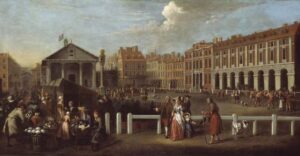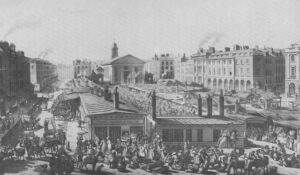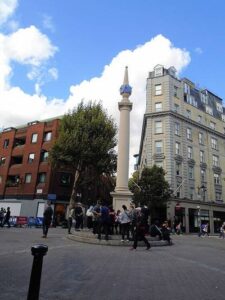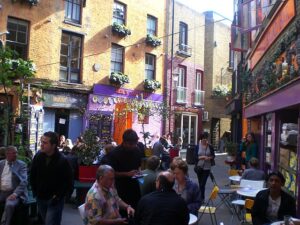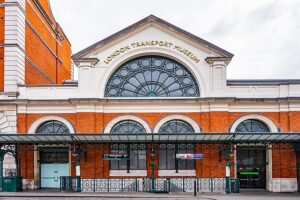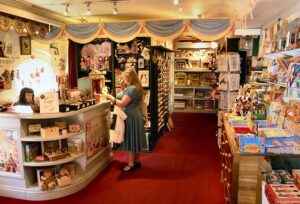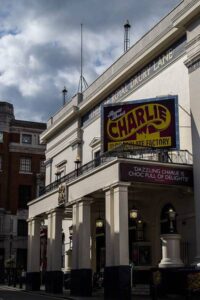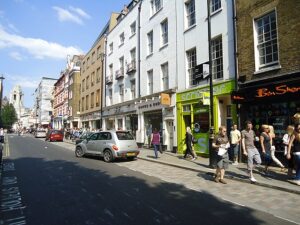The interesting history of Covent Garden
Date post added: 15th February 2024
The famous Covent Garden lies just north of The Strand in London’s West End. It was London’s foremost flower, fruit and vegetable market for over 300 years, and its open air but covered market is still a huge attraction today. It’s said that the area was a trading spot as early as Saxon times (6th century).
Whilst that remains the same, much about this popular London spot has evolved over the centuries. From its relatively humble beginnings, it transformed into a home for the aristocracy and a cultural hub for theatre, opera and ballet. Here, we’ll delve into the rich history of Covent Garden and share some of its many stories.
What was Covent Garden originally used for?
Like so many English words, the term we use now isn’t as it started life. The area of Covent Garden originally belonged to the Benedictines of Westminster who maintained a kitchen garden there. Yes, Covent Garden was the veggie patch for the monks of Westminster Abbey. It was their ‘convent garden’. Over time, its name evolved from Convent Garden to Covent Garden.
When was Covent Garden created?
When King Henry VIII decided on the dissolution of English monasteries in 1536, he seized this land. Then in 1552, his son, King Edward VI handed over the land to John Russell, 1st Earl of Bedford. The land, which stretched from The Strand to Long Acre, sat doing very little for a while. Fast forward a century to the 1630s and Francis Russell, the fourth Earl of Bedford, decided to build a house for himself in Covent Garden on the north side of The Strand.
The Earl of Bedford decided to make money out of it, and he developed the area just as the cities of London and Westminster grew. He commissioned King Charles I’s Royal Architect Inigo Jones to build a square there, with houses fit for the aristocracy. ‘The piazza’ or residential square was an Italian style and the first of its kind in London. And oh my gosh did it start something: because today London has hundreds of squares. The square is to London what canals are to Venice.
As an afterthought, Francis Russell asked Inigo Jones to put up a church “but don’t make it any better han a barn” (he didn’t want to pay for a finer one). Jones agreed, saying “you shall have the handsomest barn in London.” And he created St Paul’s Church at the western end of the Covent Garden Piazza.
The construction of the piazza is seen as the origins of Covent Garden. Significant roads in the area, Russell Street and Bedford Street, mark the family’s importance in its creation.
The origins of Covent Garden market
The first records of the ‘new market’ in Covent Garden date back to 1654. In 1656, the Duke of Bedford agreed that some temporary stalls could be built in the gardens of his home, Bedford House. This evolved and, in 1670, King Charles II granted a license to hold a market there every day except Sundays and Christmas Day. The market sold fruit, vegetables, flowers, roots, and herbs predominantly. It was around this time that the first pineapples began to be grown in England. They became super popular and the pineapple was adopted as the symbol of Covent Garden Market.
When much of the City of London was destroyed by the plague and Great Fire of London, people migrated to the West End and Covent Garden in particular. It was a desirable address.
As Covent Garden and its market grew, so did its popularity. It was a vibrant spot and that led to pleasurable pursuits springing up around it – taverns, coffee houses, book shops, gambling dens and, inevitably, brothels. There was even a publication at the time dedicated to the latter, Harris’s List of Covent Garden Ladies, the “essential guide and accessory for any serious gentleman of pleasure.”
Find out more about the sordid side of Covent Garden on our tour
Some felt the bustling market and its associated pleasurable pursuits didn’t quite fit with aristocratic society. So in 1748, the Duke of Bedford had the market rebuilt, adding in an upper storey of shops which were better suited to the upper echelons of society.
By the 19th century, the area needed another facelift. Charles Fowler was commissioned to house the market complex in the piazza. He designed the bright and colourful neo-classical building to cover and better organise the market. Whilst the Greco-Roman design seems rather ornate to us, in Victorian times it was considered quite plain when it was erected in 1830.
The market continued to grow and, over time, further buildings were added, namely the Floral Hall, Charter Market, and Jubilee Market. The Dukes of Bedford sold their interest in the market in 1918.
In 1974, Covent Garden market moved to Nine Elms in Battersea which became known as New Covent Garden Market. But the original Covent Garden site was redeveloped and the Victorian market building continues to host an array of shops, market stalls, cafes and bars.
Covent Garden: entertainment area
To entertain the 18th-century gentry, two theatres were built in the area, The first Theatre Royal on Drury Lane and the Royal Opera on Bow Street.
But Covent Garden had been synonymous with entertainment before that. Diarist Samuel Pepys wrote in 1662 about seeing his first Punch and Judy show in the neoclassical portico of St Paul’s Church. The puppet shows were held regularly to entertain the market sellers’ children and are thought to be the first of their kind in Britain. Hence the name of the well-known Covent Garden pub, The Punch and Judy, with views over to the church’s portico. This area between Covent Garden market and the portico of St Paul’s Church is still the best spot to watch some of London’s finest street performers.
St Paul’s Church became known as the Actors’ Church and many of London’s leading stars would pay their respects there. Then in 1798, there was yet another fabulous reason to visit the area – Rules Restaurant opened on Maiden Lane, serving fine food and wine. It still stands and continues to serve traditional, and truly delicious food. Rules is known as the oldest restaurant in London.
Since 1945, the Theatre Royal has been home to the Royal Opera and known as the Royal Opera House. A year later, it was joined by the Royal Ballet. It’s undergone several renovations since then, including its amalgamation with the old Floral Hall which had been part of Covent Garden Market.
What are the attractions in Covent Garden?
There’s so much to see and do in the Covent Garden area, but here are a few highlights.
Seven Dials – this area of seven streets was originally established by Thomas Neale, MP in the early 1690s. The Sundial Pillar (1693) sits at the centrepoint of the streets. In mid-Victorian times Seven Dials was well-known for its Bird Fair and the sale of animals. Today, Seven Dials Market is held in what was a banana and cucumber warehouse, and there’s plenty more shopping besides. Plus, the Donmar Warehouse and The Cambridge Theatre.
Neal’s Yard – located within Seven Dials, between Monmouth Street and Shorts Gardens – is a gorgeous courtyard with cute cafes, restaurants and shops. Every business is committed to sustainable and ethical commercial practices. You’ll find all sorts from mezze to massages, fine British cheese to authentic Italian pizza.
London Transport Museum – housed in the former flower market building on the southeast corner of Covent Garden Piazza, this museum covers the history of transportation in Britain’s capital city. It’s not just tube trains and double-decker buses. You’ll find Tudor barges, Victorian horse-drawn trams and even Georgian sedan chairs.
Pollock’s Toy Shop – the first Pollock’s Toy Shop opened in Covent Garden in the 1880s. He made exquisite toy theatres at that time. Pollock’s Toys are still in Covent Garden market today, and there’s Pollock’s Toy Museum on nearby Scala Street which celebrates historical toys, games and theatres.
Drury Lane– this is the heart of Theatreland in the West End. The most famous theatre is the Theatre Royal on Drury Lane which first opened in 1663, making it the oldest continuously used theatre in London. It’s on its fourth regeneration, but it’s still standing and hosting audiences.
Long Acre – running from St Martin’s Lane to Drury Lane, Long Acre is one of the best-known streets in Covent Garden. Once known as the home of coach-makers and then car dealers, these days you’re more likely to find cocktails, craft beer, coffee shops and fashion stores.
Want to know more about Covent Garden? Join us each Thursday morning on the guided Covent Garden walking tour. Look out for our special Musical Covent Garden tours too!

